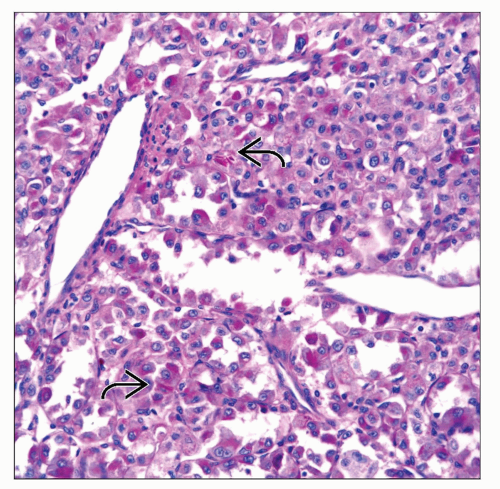Alveolar Soft Part Sarcoma
Key Facts
Clinical Issues
Incidence
Extremely rare tumor in mediastinal compartment
Appears to be more common in young adults in 3rd decade of life
More common in soft tissues of extremities &/or head and neck
Symptoms
Chest pain
Dyspnea
Cough
Asymptomatic
Top Differential Diagnoses
Rhabdomyosarcoma
Positive for muscle markers, including MYOD1, myoglobin, and desmin
Melanoma
Positive for S100, HMB-45, and mart-1
Paraganglioma
Positive for neuroendocrine markers, such as chromogranin-A and synaptophysin
Thymic carcinoma
Carcinomas usually will show positive staining for epithelial markers, such as keratins and EMA/MUC1
Diagnostic Checklist
Alveolar growth pattern
Large cells with ample cytoplasm
Presence of intracytoplasmic crystals, especially using PAS histochemical stains
Mitotic figures are rare
 Low-power view shows an alveolar soft part sarcoma with a neoplastic cellular proliferation arranged in an alveolar growth pattern almost mimicking alveolated lung tissue. |
TERMINOLOGY
Definitions
Malignant neoplasm of soft tissues
ETIOLOGY/PATHOGENESIS
Etiology
Although it has been speculated in the past as possible neurogenic or myogenic origin, its etiology remains unknown
CLINICAL ISSUES
Epidemiology
Incidence
Extremely rare tumor in mediastinal compartment
Age
Appears to be more common in young adults in 3rd decade of life
Gender
No gender predilection
Site
More common in soft tissues of extremities &/or head and neck
Anterior or posterior mediastinum
Presentation
Chest pain
Dyspnea
Cough
Asymptomatic
Treatment
Chemotherapy
Radiation therapy
Surgical resection
Prognosis
Variable
Tumor can metastasize
Short- and long-term survivals have been reported
MACROSCOPIC FEATURES
General Features
Fleshy, soft, and hemorrhagic tumor mass
Size
Varies in size and can be > 10 cm in diameter
MICROSCOPIC PATHOLOGY
Histologic Features
Alveolated growth pattern
Large polygonal cells
Well-defined cell borders
Ample cytoplasm
Eccentrically placed nuclei
Mild to moderate nuclear atypia
Mitoses are rare
Intracytoplasmic crystals
DIFFERENTIAL DIAGNOSIS
Rhabdomyosarcoma
Positive for muscle markers, including MYOD1, myoglobin, and desmin
Melanoma
Positive for S100, HMB-45, and mart-1
Paraganglioma
Positive for neuroendocrine markers, such as chromogranin-A and synaptophysin
Thymic Carcinoma
Carcinomas usually will show positive staining for epithelial markers, such as keratins and EMA/MUC1
DIAGNOSTIC CHECKLIST
Clinically Relevant Pathologic Features
Cytoplasmic features
Pathologic Interpretation Pearls
Alveolar growth pattern
Large cells with ample cytoplasm
Presence of intracytoplasmic crystals
Mitotic figures are rare
SELECTED REFERENCES
1. Daigeler A et al: Alveolar soft part sarcoma: clinicopathological findings in a series of 11 cases. World J Surg Oncol. 6:71, 2008
Stay updated, free articles. Join our Telegram channel

Full access? Get Clinical Tree




